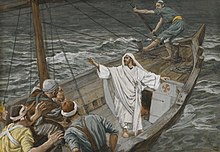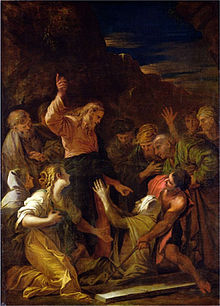Synoptic Gospels
This strong parallelism among the three gospels in content, arrangement, and specific language is widely attributed to literary interdependence,[3] though the role of orality and memorization of sources has also been explored by scholars.They also differ from non-canonical sources, such as the Gospel of Thomas, in that they belong to the ancient genre of biography,[8][9] collecting not only Jesus' teachings, but recounting in an orderly way his origins, his ministry, and his passion, and alleged miracles, and resurrection.Though each gospel includes some unique material, the majority of Mark and roughly half of Matthew and Luke coincide in content, in much the same sequence, often nearly verbatim.An illustrative example of the three texts in parallel is the healing of the leper:[15] Καὶ ἰδοὺ, λεπρὸς προσελθὼν προσεκύνει αὐτῷ λέγων· Κύριε, ἐὰν θέλῃς δύνασαί με καθαρίσαι.Καὶ ἰδοὺ, ἀνὴρ πλήρης λέπρας· ἰδὼν δὲ τὸν Ἰησοῦν πεσὼν ἐπὶ πρόσωπον ἐδεήθη αὐτοῦ λέγων· Κύριε, ἐὰν θέλῃς δύνασαί με καθαρίσαι.[17] Mark's additions within the triple tradition tend to be explanatory elaborations (e.g., "the stone was rolled back, for it was very large"[18]) or Aramaisms (e.g., "Talitha kum!"[19]).Alan Kirk praises Matthew in particular for his "scribal memory competence" and "his high esteem for and careful handling of both Mark and Q", which makes claims the latter two works are significantly different in terms of theology or historical reliability dubious.[30] An extensive set of material—some two hundred verses, or roughly half the length of the triple tradition—are the pericopae shared between Matthew and Luke, but absent in Mark.Ancient sources virtually unanimously ascribe the synoptic gospels to the apostle Matthew, to Peter's interpreter Mark, and to Paul's companion Luke—hence their respective canonical names.[53] A remark by Augustine of Hippo at the beginning of the fifth century presents the gospels as composed in their canonical order (Matthew, Mark, Luke, John), with each evangelist thoughtfully building upon and supplementing the work of his predecessors—the Augustinian hypothesis (Matthew–Mark).[54] This view (when any model of dependence was considered at all) seldom came into question until the late eighteenth century, when Johann Jakob Griesbach published in 1776 a synopsis of the synoptic gospels.Griesbach, noticing the special place of Mark in the synopsis, hypothesized Marcan posteriority and advanced (as Henry Owen had a few years earlier[55]) the two-gospel hypothesis (Matthew–Luke).In a theory first proposed by Christian Hermann Weisse in 1838, the double tradition was explained by Matthew and Luke independently using two sources—thus, the two-source (Mark–Q) theory—which supplemented Mark with another hypothetical source consisting mostly of sayings.[56] This two-source theory eventually won wide acceptance and was seldom questioned until the late twentieth century; most scholars simply took this new orthodoxy for granted and directed their efforts toward Q itself, and this is still[update] largely the case.This exemplifies the prevailing scholarship of the time, which saw the canonical gospels as late products, dating from well into the second century, composed by unsophisticated cut-and-paste redactors out of a progression of written sources, and derived in turn from oral traditions and from folklore that had evolved in various communities.[58] New attention is also being given (for example, by Robert MacEwen and Alan Garrow) to the Wilke hypothesis of 1838 which, like Farrer, dispenses with Q but ascribes the double tradition to Matthew's direct use of Luke (Matthean Posteriority).[citation needed] On this collapse of consensus, Wenham observed: "I found myself in the Synoptic Problem Seminar of the Society for New Testament Studies, whose members were in disagreement over every aspect of the subject.





calming of the stormCanonsTanakhNevi'imKetuvimOld Testament (OT)New Testament (NT)DeuterocanonAntilegomenaChapters and versesApocryphaJewishAuthorshipDatingHebrew canonOld Testament canonNew Testament canonComposition of the TorahMosaic authorshipPauline epistlesPetrine epistlesJohannine worksTranslationsmanuscriptsDead Sea scrollsMasoretic TextSamaritan PentateuchTargumimSeptuagintPeshittaVetus LatinaVulgateGothic BibleLuther BibleEnglish Biblesby languageBiblical studiesArcheologyArtifactsHistoricityInternal consistencyPeoplePlacesBiblia Hebraica StuttgartensiaRahlfs' SeptuagintNovum Testamentum GraeceDocumentary hypothesisNT textual categoriesBiblical criticismHistoricalTextualSourceRedactionCanonicalHermeneuticsPesherMidrashPardesAllegorical interpretationHistorical-grammatical methodInspirationLiteralismAlcoholConspiracy theoryEthicsCapital punishmentHomosexualityIncestMuhammadProphecySerpentsSlaveryViolenceWarfareGnosticIslamicQuranicInerrancyInfallibilityCriticism of the BibleBiblical authorityOutline of Bible-related topicsgospelsMatthewromanizedparallelismMarcan priorityKoine GreekGospel of ThomasJohn the BaptistBaptismtemptationFirst disciples of JesusHometown rejection of JesusPeter's mother-in-lawdemoniacsparalyticCall of the tax collectorNew Wine into Old WineskinsMan with withered handCommissioning the Twelve ApostlesThe Beelzebul controversyparable of the strong maneternal sinHis true relativesparable of the sowerlamp under a bushelparable of the mustard seedCalming the stormThe Gerasene demoniacdaughter of Jairusbleeding womanFeeding the 5000Confession of PeterTransfigurationThe demoniac boyThe little childrenThe rich young manJesus predicts his deathBlind near JerichoPalm SundayCasting out the money changersRender unto CaesarWoes of the PhariseesSecond Coming ProphecyLast Supper